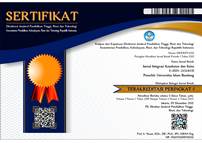Pengaruh Paparan Asap Rokok Tersier terhadap Kadar Glukosa Darah Mencit
Abstract
Peningkatan jumlah perokok aktif mungkin berimplikasi pada peningkatan jumlah perokok sekunder dan tersier. Salah satu dampak buruk rokok, yaitu dapat meningkatkan kadar gula darah. Tujuan penelitian adalah menganalisis pengaruh paparan asap rokok tersier terhadap kadar glukosa darah mencit. Penelitian ini merupakan penelitian eksperimental in vivo dengan subjek penelitian mencit yang dibagi dalam dua kelompok, yaitu kelompok kontrol yang tidak diberikan perlakuan dan kelompok perlakuan yang diberi asap rokok tersier selama 29 hari. Penelitian dilakukan di Laboratorium Bio Medik Fakultas Kedokteran Unisba periode Maret–Juli 2019. Pemeriksaan darah dilakukan pada tiga periode, yaitu minggu ke-0, ke-2, dan ke-4. Hasil penelitian menunjukkan kadar glukosa darah kelompok perlakuan (203,8 mg/dL) lebih tinggi dibanding dengan kelompok kontrol (163 mg/dL) pada minggu ke-4. Hasil uji t independen memperlihatkan nilai p lebih kecil dari 0,05 (p<0,05). Adapun pada kelompok kontrol (p=0,450) dan perlakuan (p=0,120) tidak terdapat perbedaan kadar glukosa darah antara minggu ke-0 dan ke-4. Hasil uji t dependen memperlihatkan nilai p lebih besar dari 0,05 (p>0,05). Hasil ini mengindikasikan bahwa paparan asap rokok tersier pada penelitian ini memengaruhi kadar glukosa darah. Asap rokok tersier mengandung berbagai bahan yang berbahaya salah satunya nikotin yang dapat memengaruhi metabolisme glukosa dengan cara menginduksi keadaan stres oksidatif yang dapat merusak lipid, protein, dan dapat memengaruhi kemampuan sel untuk mengatur kadar gula darah dalam tubuh sehingga dapat terlihat hiperglikemia pada mencit yang terpapar asap rokok tersier.
EFFECT OF THIRDHAND SMOKE EXPOSURE ON BLOOD GLUCOSE LEVEL IN MICE
Increasing the number of active smokers has implications for the increasing number of secondary and tertiary smokers. One of the bad effects of smoking is it can increase blood sugar levels. The purpose of the research was to analyze the effect of tertiary cigarette smoke exposure on mice blood glucose levels. This research is kind of exposure in vivo experimental study with mice research subjects divided into two groups: a control group that was not given treatment and a treatment group that was given tertiary cigarette smoke for 29 days with blood tests carried out in three periods namely 0, 2nd, and 4th weeks. The study was conducted in Biomedic Laboratory Universitas Islam Bandung during March –July. The results showed the blood glucose level of the treatment group (203.8 mg/dL) was higher than the control group (163 mg/dL) at the 4th week. Independent T-test results showed that the p value was less than 0.05 (p <0.05). As for the control (p = 0.450) and treatment group (p = 0.120) there were no differences in blood glucose levels between at weeks 0 and 4. Dependent T-test results showed a p value greater than 0.05 (p> 0.05). These results indicate that tertiary cigarette smoke was exposure in this study affects blood glucose levels. Tertiary cigarette smoke contains a variety of harmful ingredients, such as nicotine which can affects glucose metabolism by inducing oxidative stress that can damage lipids, proteins, and can affects the ability of cells to regulate blood sugar levels in the body that hyperglycemia can be seen in mice which is exposed to thirdhand smoke.
Keywords
Full Text:
PDFReferences
Badan Penelitian dan Pengembangan Kesehatan, Kementerian Kesehatan Republik Indonesia. Riset kesehatan dasar (Riskesdas) 2010. Jakarta: Badan Penelitian dan Pengembangan Kesehatan, Kemenkes RI; 2010.
Badan Penelitian dan Pengembangan Kesehatan, Kementerian Kesehatan Republik Indonesia. Riset kesehatan dasar (Riskesdas) 2018. Jakarta: Badan Penelitian dan Pengembangan Kesehatan, Kemenkes RI; 2018. [diunduh 5 April 2019] Tersedia dari: https://www.kemkes.go.id/resources/download/info-terkini/hasil-riskesdas-2018.pdf
Yu M, Mukai K, Tsai M, Galli SJ. Thirdhand smoke component can exacerbate a mouse asthma model through mast cells. J Allergy Clin Immunol. 2018 Nov;142(5):1618–27.
Scotland ASH. ASH Scotland third-hand smoke. 2011. [diunduh 8 April 2019]. Tersedia dari: http://www.ashscotland.org.uk/media/3942/Thirdhandsmoke.pdf
Hang B, Sarker AH, Havel C, Saha S, Hazra TK, Schick S, dkk. Thirdhand smoke causes DNA damage in human cells. Mutagenesis. 2013 Jul;28(4):381–91.
Adhami N, Starck SR, Flores C, Green MM. A health threat to bystanders living in the homes of smokers: how smoke toxins deposited on surfaces can cause insulin resistance. PLoS One. 2016 Mar 2;11(3):e0149510.
Gibbs K, Collaco JM, McGrath-Morrow SA. Impact of tobacco smoke and nicotine exposure on lung development. Chest. 2016 Feb;149(2):552–61.
Kumar V, Abbas A, Aster J. Pathologic basis of disease. Edisi ke-9. Philadelphia. Elsevier Inc.; 2015.
Rakel RE, Houston T. 49 - Nicotine addiction [Internet]. Edisi ke-9. Textbook of family medicine. Philadelphia: Elsevier Inc.; 2018.
Ario MD. Pengaruh nikotin dalam rokok pada diabetes melitus tipe 2. J Majority. 2014;3(7):75–80.
DOI: https://doi.org/10.29313/jiks.v2i1.5633
Refbacks
- There are currently no refbacks.
Jurnal Integrasi Kesehatan dan Sains is licensed under a Creative Commons Attribution-NonCommercial-ShareAlike 4.0 International License.







.png)
_(1).png)




















